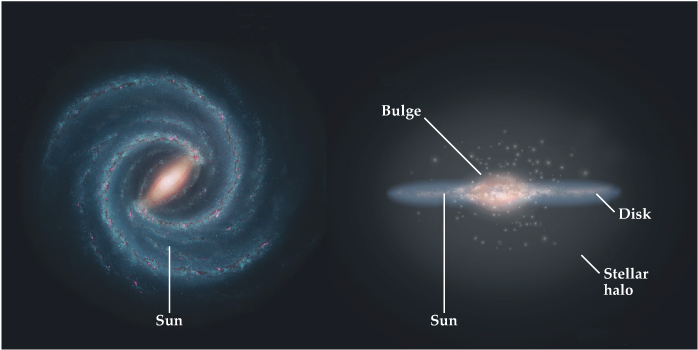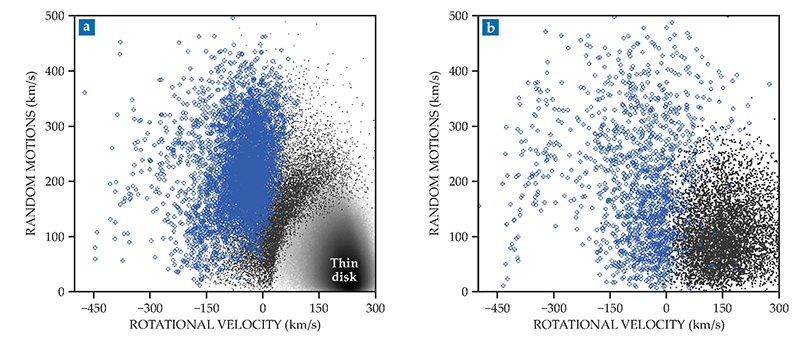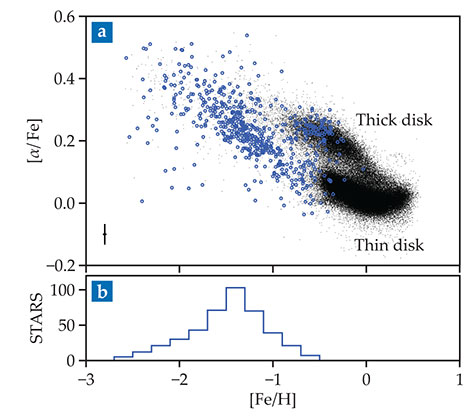An ancient merger helped form our galaxy
DOI: 10.1063/PT.3.4107
The Gaia space observatory, built, launched, and managed by the European Space Agency, aims to create the most ambitious star catalog to date: a map of about 1% of the estimated 100 billion–400 billion stars in the Milky Way. The first data release in September 2016, DR1, provided astrometric information for about 1.1 billion stars. The second data set, DR2, released in April 2018, includes celestial positions for almost 1.7 billion additional stars. 1
When a star is formed, it usually keeps the orbital energy and angular momentum from its parent galaxy (see the article by Joseph Silk, Physics Today, April 1987, page 28
From the new data, astronomers Giuliano Iorio and Vasily Belokurov from the University of Cambridge have found new evidence that the Milky Way merged with a smaller galaxy long before the birth of our solar system. 2 A second, independent team, led by the University of Groningen’s Amina Helmi, came to the same conclusion and determined that the merging galaxy collided with ours about 10 billion years ago. 3 The work from both teams suggests that most of the galaxy’s halo, a diffuse sphere of stars that envelops the galactic disk, was formed from that singular event.
Stars, stars everywhere
Our location deep inside the Milky Way, 8 kiloparsecs (about 26 000 light-years) from the center, makes it impossible to see the galaxy from a bird’s-eye view, but we can infer its structure. The barred spiral galaxy, as shown in figure
Figure 1.

The structure of the Milky Way galaxy. The Sun is about 8 kiloparsecs (about 26 000 light-years) from the galactic center. The disk is composed of a thin component surrounded by a thick component. The halo, a diffuse sphere of stars, envelops the galactic disk. (Left image by NASA/JPL-Caltech; right, ESA; layout, ESA/ATG medialab.)

From the Gaia DR2 catalog, Iorio and Belokurov selected about 93 000 stars after removing those associated with globular clusters, satellite galaxies, and binary stars whose spectra cannot be resolved from one another. The stars are all of a type known as RR Lyrae stars and are located within 30 kpc of the galaxy’s center. Belokurov says they “are a perfect tracer of the accreted stellar populations. They don’t have contamination from the disk and can be found at many different distances from the center.”
To analyze how the star density changes as a function of position in the galaxy, Iorio and Belokurov subdivided the sample into groups based on the stars’ displacement from the galactic disk. They found that the stars’ orbits in the inner halo, which is 5–10 kpc from the disk, were stretched and elongated. The shape indicated that in its past the Milky Way may have experienced a merger near the disk. When a galaxy merges with another, “the stars themselves are collisionless,” says Belokurov. In a simplified, one-dimensional picture, when two galaxies smash together, he says, “the final configuration will be stretched along the line connecting them.”
Whereas Iorio and Belokurov focused on stars far from the Sun, Helmi and her team selected stars within 2.5 kpc of it. “What our team discovered,” she says, “is that there are a large number of stars moving in elongated and retrograde orbits.” Figure
Figure 2.

Velocity distribution of stars in the Sun’s vicinity reveals two populations of different origin. (a) Velocity components of stars that are within 2.5 kiloparsecs (about 8200 light-years) of the Sun. Blue dots represent halo stars with predominantly retrograde orbits; black dots, halo stars without retrograde orbits and stars in the galactic disk. (b) Velocity components inferred from a simulation of a merger that formed the galactic disk. (Adapted from ref.

Evidence from chemical abundances
The idea that a large satellite galaxy merged with the Milky Way is not new. In a 2018 study, 4 Belokurov and colleagues analyzed stars located about 10 kpc from the Sun. They looked at velocity information from Gaia DR1 and chemical abundance data from the Sloan Digital Sky Survey. As a proxy for the rate of star formation, they used the abundance of iron relative to hydrogen.
When stars in a galaxy explode in supernovae, they enrich the gas around them with elements heavier than helium (see the article by Anna Frebel and Timothy C. Beers, Physics Today, January 2018, page 30
Although Helmi and her group had previously studied mergers, the release of Gaia DR2 allowed them to compare a larger sample of star velocities with their chemical abundances and test the merger hypothesis more rigorously. The chemical abundance information came from cross-referencing their Gaia data with that from the Apache Point Observatory Galactic Evolution Experiment. “The chemistry really pinned it down,” says Helmi. In a plot of chemical abundance shown in figure
Figure 3.

Chemical abundances of stars in the Sun’s vicinity reflect their origin. In (a), the same sample of stars from figure

The chemical abundance analysis also allowed Helmi and her team to estimate the merger’s timing. The researchers plotted the stars on a Hertzsprung–Russell diagram, which at its simplest shows a star’s brightness as a function of its temperature, or color. A model developed in 2014 determines a star’s age based on its metallicity and location in the Hertzsprung–Russell diagram. 5 By matching age-modeling data with their sample of stars near the Sun, Helmi and her colleagues estimate that a merger happened roughly 10 billion years ago.
Simulating collision
To increase confidence in their observational results, Iorio and Belokurov compared the proper motions of their Gaia DR2 star selection with three kinematic models of star velocity. In the isotropic model, the radial- and tangential-velocity components are equal. In the radially anisotropic model, radial components are higher than tangential components. Those components are reversed in the tangentially anisotropic model.
The proper motions of most stars between 4 kpc and 30 kpc from the galactic center agreed best with the radially anisotropic model, which is expected after a major merger. What’s more, the researchers inferred that most other halo-star kinematics indicate a merger, providing further support that the satellite galaxy was massive.
Helmi and her colleagues reached a similar conclusion. When they first plotted the retrograde stars, as seen in figure
Now that the merger hypothesis has stronger support, one of the next research topics is learning how the event unfolded. “I think you need to go one step further and describe what happened to the gas,” says Helmi. “In the past, galaxies were richer in gas, so that must have had a huge impact on star formation.” The Gaia DR2 is an intermediate collection of data; an even larger and more complete star catalog should be completed in 2021.
References
1. Gaia collaboration, Astron. Astrophys. 616, A1 (2018). https://doi.org/10.1051/0004-6361/201833051
2. G. Iorio, V. Belokurov, Mon. Not. R. Astron. Soc. 482, 3868 (2019). https://doi.org/10.1093/mnras/sty2806
3. A. Helmi et al., Nature 563, 85 (2018). https://doi.org/10.1038/s41586-018-0625-x
4. V. Belokurov et al., Mon. Not. R. Astron. Soc. 478, 611 (2018). https://doi.org/10.1093/mnras/sty982
5. K. Hawkins et al., Mon. Not. R. Astron. Soc. 445, 2575 (2014). https://doi.org/10.1093/mnras/stu1910
6. A. Villalobos, A. Helmi, Mon. Not. R. Astron. Soc. 391, 1806 (2008). https://doi.org/10.1111/j.1365-2966.2008.13979.x
More about the Authors
Alex Lopatka. alopatka@aip.org
